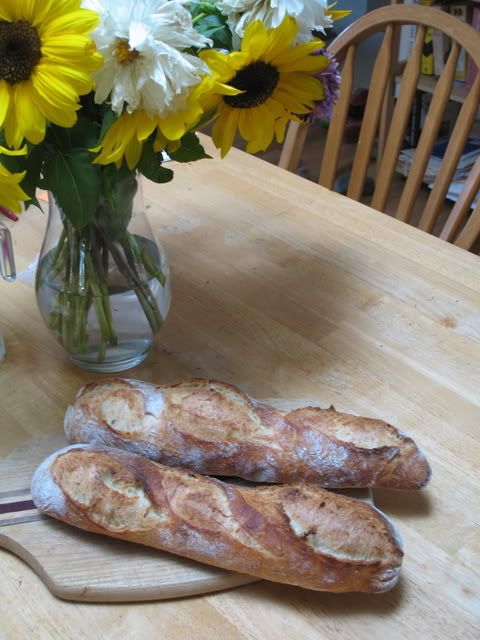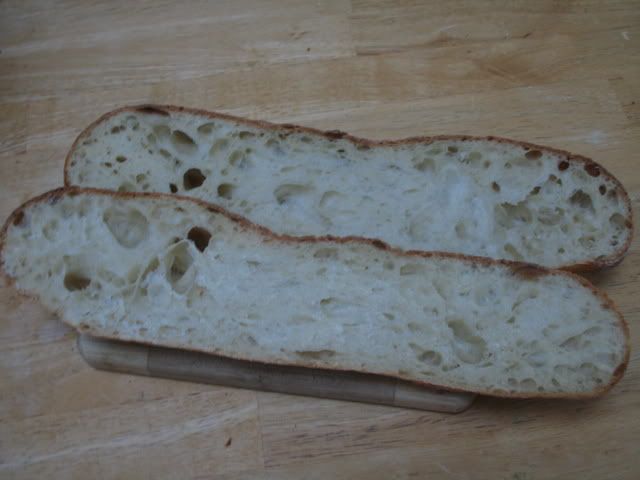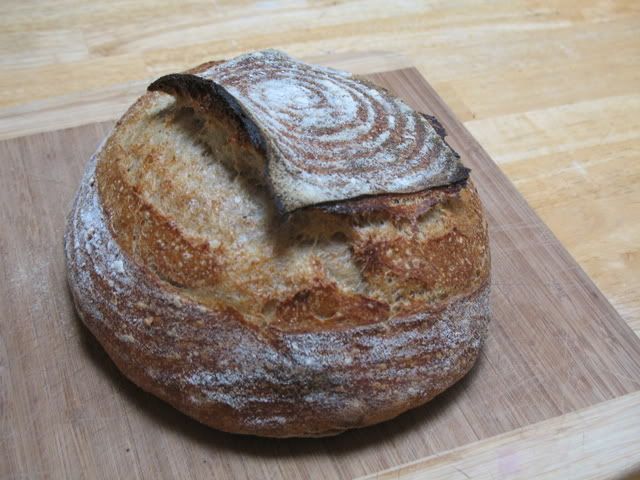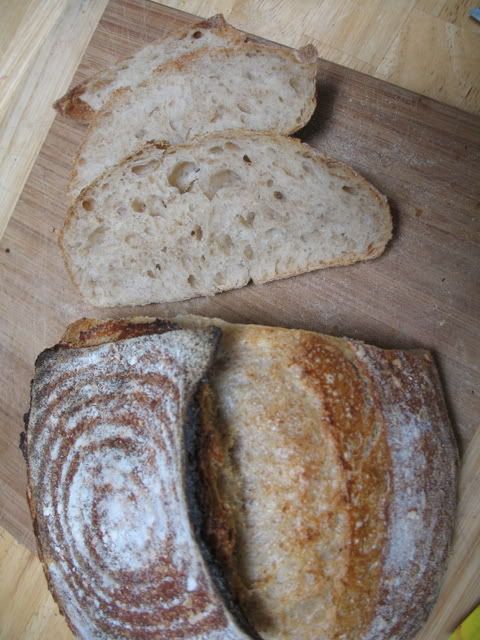I realize that I seriously risk tanking my whole grain cred, here, but lately ... I've been taking a shine to poolish. It'd been a long time since I'd worked with yeasted pre-ferments, and aside from an occasional baguette here and there, I'd not make a serious white bread in quite some time.
But after the New Year, in the course of just a couple of days, I made three poolish baguettes and one poolish ciabatta.
I used Jeffrey Hamelman's masterpiece Bread as a guide. I was so pleased with the baguettes, that for the ciabatta, I modified my sourdough spreadsheet to accommodate commercial yeast breads with pre-ferments, and inserted his formulas.. Aside from scaling each recipe down (I made a half-batch of poolish baguettes, which made three demi-baguetts, and a single 1.5 pound ciabatta), the only other change I made was to add a tiny speck of yeast to each poolish. With the baguettes, since they required about 1/10 gram of yeast, I added one gram of yeast to 19 grams of water and then added two grams of the solution to the poolish.
This was a pain.
So, next time, I just eyeballed about 1/4 of 1/8 tsp of yeast. Both ways turned out fine.
The biggest takeaway for me from making both of these breads is that, so long as the bread is handled firmly but gently and the loaf is well-shaped, the crumb can still be very open without a super gloppy dough. The baguettes, for instance, are just 66 percent hydration and the ciabatta is 73 percent. Of course, the poolish probably helps, since it denatures the protein and makes it more extensible. All the same, the lesson for me stands - good handling goes a long way towards getting an open crumb.
Sourdough is still my preference, but, wow, I'd forgotten how tasty a good, simple loaf of French bread is: nutty, buttery with a strong wheaty flavor that lasts, and lasts, and lasts.
Here's the photographic results. Recipes are below.
Poolish Baguettes
I'm finally starting to the hang of shaping these buggers.

I cut these in half the next day to make garlic bread and cheese bread to go with pasta.

Ciabatta with Poolish
This is, without doubt, the prettiest ciabatta I've ever made. I didn't score it - it just opened up on its own.

And an interior shot. Not as open as some ciabattas I've seen, but open enough for me. Next time, I'll bump the hydration up to 75 or maybe 78 percent.

Recipes
Poolish Baguettes (Makes 3 demi-baguettes of about 8 oz. each):
Overall formula:
- White flour: 100%
- Water: 66%
- Salt: 2%
- Instant yeast: 0.36%
- 33% of the flour is pre-fermented as a poolish at 100% hydration with .07% yeast
Poolish:
- White flour: 5.3 oz
- Water: 5.3 oz
- Instant yeast: Just a speck (about 1/32 of a tsp)
Final dough:
- All of the poolish
- White flour: 10.7 oz
- Water: 5.3 oz
- Salt: 1.5 tsp
- Instant yeast: 1/2 + 1/8 tsp
The night before, dissolve the yeast into the water for the poolish, and then mix in the flour. Cover and let it ferment at room temperature for 12-16 hours. Once the poolish has bubbles breaking on top and has started to wrinkle, it's ready. It'll also smell ... really nice - sweet and nutty. Mmmm.
For the final dough, measure out the water and pour it into the poolish to loosen it up. Then pour the entire mixture into a bowl. Mix together the salt, yeast and flour, and then add it to the bowl as well. Mix it all up with a spoon and, once everything is hydrated, knead it for about 5 to 10 minutes, until it passes the windowpane test. Cover and let it ferment for two hours, giving it a stretch-and-fold at the one hour mark.
Divide the dough into three pieces, and preshape into rounds. Cover and let them rest about 20 minutes. Then shape into baguettes and cover, letting them rise for about 1 hour to 90 minutes. Score and bake on a preheated stone in a 460 degree oven with steam for about 25 minutes.
Ciabatta with Poolish (Makes one 1.5 lb loaf):
Overall formula:
- White flour: 100%
- Water: 73%
- Salt: 2%
- Instant yeast: 0.36%
- 30% of the flour is pre-fermented as a poolish at 100% hydration with .07% yeast
This is all in grams, because I used my spreadsheet - Hamelman uses ounces.
Poolish:
- White flour: 136 grams
- Water: 136 grams
- Instant yeast: Just a speck (about 1/32 of a tsp or 1/10 of a gram)
Final dough:
- All of the poolish
- White flour: 318 grams
- Water: 195 grams
- Salt: 9 grams
- Instant yeast: A heaping 1/8 tsp or .5 grams
The night before, dissolve the yeast into the water for the poolish, and then mix in the flour. Cover and let it ferment at room temperature for 12-16 hours. Once the poolish has bubbles breaking on top and has started to wrinkle, it's ready. It'll also smell ... really nice - sweet and nutty.
For the final dough, measure out the water and pour it into the poolish to loosen it up. Then pour the entire mixture into a bowl. Mix together the salt, yeast and flour, and then add it to the bowl as well. Mix it all up with a spoon and let it sit for one hour. At one hour, give it a stretch and fold, followed by two more every 30 minutes. Then let it ferment for one more hour, for a total of 3 hours bulk fermentation.
Remove the dough onto a well floured surface, and pat it out into a rectangle, carefully degassing any truly gigantic bubbles that you noticee. Let it rest for about 90 minutes.
Tranfer to the oven, dimpling it with your fingers if you desire, onto a hot stone at 460 degrees with steam for about 35 minutes or so. Let it rest one hour before slicing.






















